Bio Midterm 2

Biology Midterm 2 Quiz
Welcome to the Biology Midterm 2 Quiz! Test your knowledge on various topics including genetics, cell division, and human diseases. This quiz is designed to challenge students and enthusiasts alike!
- 66 Questions
- Multiple Choice Format
- Track Your Score
Non-disjunction causing aneuploidy in an embryo occurs when?
Only during Meiosis 1
Can occur during either Meiosis 1 or Meiosis 2
Must occur during both Meiosis 1 and Mitosis
Only during Meiosis 2
Must occur during both Meiosis 2 and Mitosis
Only during Mitosis
What blood type is considered the universal recipient?
Type AB
Type O
Type A
Type B
There is no universal donor, only a universal recipient
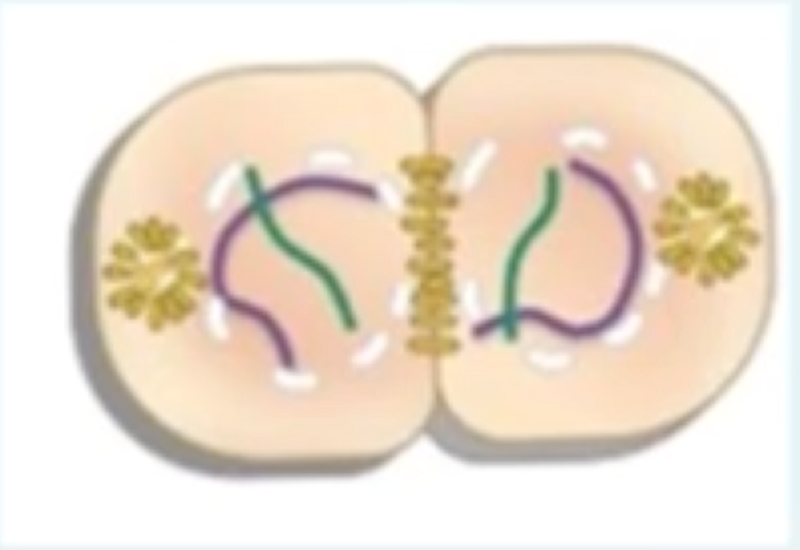
What describes the phase of cell division this cell is currently going through. The 2n number is 4.
Telophase meiosis 1
Telophase mitosis
Anaphase meiosis 2
Anaphase mitosis
Metaphase meiosis 2
Prophase meiosis 1
Anaphase meiosis 1
Metaphase mitosis
Prophase mitosis
Metaphase meiosis 1
Telophase meiosis 2
Which of the following would be considered aneuploidy?
1n
2n+n
3n
2n-1
2n
The condition known as sickle cell anemia is caused by...
A gradual deviation of the nervous system resulting in a loss of cognitive abilities and eventually death
A mutation causing the blood vessels to greatly constrict
A mutation to the hemoglobin protein resulting in a change of a single amino acid
A mutation to the hemoglobin molecule resulting in an unusually thick mucous in the lungs and digestive tract
Trisomy 18 is more often referred to as?
Turner's Syndrome
Edward's syndrome
Down's syndrome
Monk's syndrome
Klinefelter's syndrome
Trisomy 21 is more often referred to as?
Turner's Syndrome
Edward's syndrome
Down's syndrome
Monk's syndrome
Klinefelter's syndrome
Which of the following are autosomal aneuploidy.
Turner's Syndrome
Edward's syndrome
Down's syndrome
Monk's syndrome
Klinefelter's syndrome
Jacob's Syndrome
Which of the following are sex-linked Aneuploidy
Turner's Syndrome
Edward's syndrome
Down's syndrome
Monk's syndrome
Klinefelter's syndrome
Jacob's syndrome
A woman with normal vision marries a man with normal vision and they have a colourblind son. Her husband dies and she marries a colour blind man. Show the type of children that might be expected from the second marriage and the proportions of each.
Theres not enough information to answer the question
All the girls would be normal and all the boys would be colourblind
1/4 XCXC, 1/4 XCXc, 1/4 XCY, 1/4XcY
1/4 XCXc, 1/4 XcXc, 1/4 XCYC, 1/4 XcYc
1/4 XCXC, 1/4 XCXc, 1/4 XCYC, 1/4 XcYc
1/4 XCXc, 1/4 XcXc, 1/4 XCY, 1/4 XcY
In a rare species of plant, the blue flower colour is dominant to red and small leaves are dominant to large. If a red plant is crossed with a heterozygous blue flower, then what percentage of the offspring will be blue?
100%
25%
0%
50%
75%
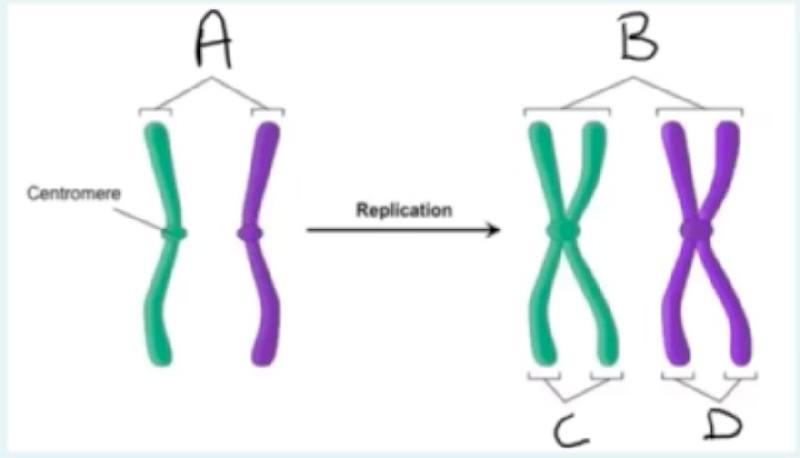
What best describes the chromosomes labelled A?
These are unduplicated homologous pairs
These are duplicated homologous pairs
These are duplicated sister chromatids
These are unduplicated sister chromatids
The risk of having a child with trisomy disorders appears to be linked to what factors?
The age of the mother
It is found in people of African background
If the mother drinks alcohol during the pregnancy
It is found in people of European background
The age of the father
About 70 percent of Americans get a bitter taste from a drug, phenyl thiocarbamide (PTC); the others do not. The ability to taste this drug results from a dominant gene while taste-blindness is recessive. A normally pigmented woman who is taste-blind has a father who is an albino-taster. She marries an albino man who is a taster, but who has a mother who is taste-blind. Show the types of children which this couple may have
25% pigmented taster, 50% pigmented taste-blind, 25% albino taster
25% pigmented taster, 25% pigmented taste-blind, 25% albino taster, 25% albino taste-blind.
9/16 pigmented taster, 6/16 pigmented non-taster, 1/16 albino non-taster.
9/16 pigmented taster, 6/16 albino taster, 1/16 albino non-taster.
There is not enough information to properly answer this question.
9/16 pigmented taster, 3/16 pigmented non-taster, 4/16 albino taster
9/16 pigmented taster, 3/16 pigmented non-taster, 3/16 albino taster, 1/16 albino non-taster.
50% pigmented taster, 25% albino taster, 25% albino taste-blind.
Sickle cell anemia is a potentially lethal disease, yet the allele for the disease remains relatively common in certain populations. Why?
The populations that have the disease tend to live in areas with a high incidence of cholera
People who are homozygote for the disease are likely to have an increased rate of fertility
The populations where it is common tend to be relatively isolated
People who are homozygote for the disease are likely to be more resistant to cholera
People who are heterozygote for the disease gave an increased survival rate for malaria
Cystic fibrosis is associated with people from what ethnicity?
People of Eastern European descent
The disease is not liked to any one ethnicity, it's linked to children of
People of Middle-Eastern descent
People of Western European Descent
People of African descent

The section indicated with an E is:
Mitosis and Cytokinesis
Mitosis
G1
S
G2
Meiosis
Interphase
Prophase

What best describes the phase of cell division this cell is currently going through. The 2n number is 4.
Metaphase meiosis 2
Metaphase mitosis
Telophase meiosis 2
Telophase mitosis
Anaphase meiosis 2
Anaphase mitosis
Prophase meiosis 1
Telophase meiosis 1
Metaphase meiosis 1
Prophase mitosis
Anaphase meiosis 1

What best describes the phase of cell division this cell is currently going through. The 2n number is 4.
Prophase meiosis 1
Anaphase mitosis
Metaphase meiosis 1
Anaphase meiosis 2
Prophase mitosis
Telophase meiosis 2
Telophase mitosis
Metaphase meiosis 2
Metaphase mitosis
Telophase meiosis 1
Anaphase meiosis 1
What best describes polyploidy?
2n
2n+1
2n-1
3n
If a person shows the characteristic of a recessive phenotype for a particular trait, what does this tell you about the person's genotype?
The person has one recessive allele
We cannot tell anything about the person's genotype without looking at their offspring
The person is an albino
The person has recessive allele for all traits
The person is homozygous for that trait

What best describes the phase of cell division this cell is currently going through. The 2n number is 4.
Metaphase meiosis 1
Prophase meiosis 1
Prophase mitosis
Telophase meiosis 1
Metaphase mitosis
Anaphase mitosis
Anaphase meiosis 2
Telophase mitosis
Metaphase meiosis 2
Anaphase meiosis 1
Telophase meiosis 2
What inheritance pattern would be the most likely if you found a bell-curve distribution for the trait?
Genetic inheritance cannot account for a bell curve. A bell curve distribution indicates that the trait is environmentally controlled
Codominance
Pleiotropic Inheritance
Incomplete dominance
Polygenic inheritance
Simple Dominance
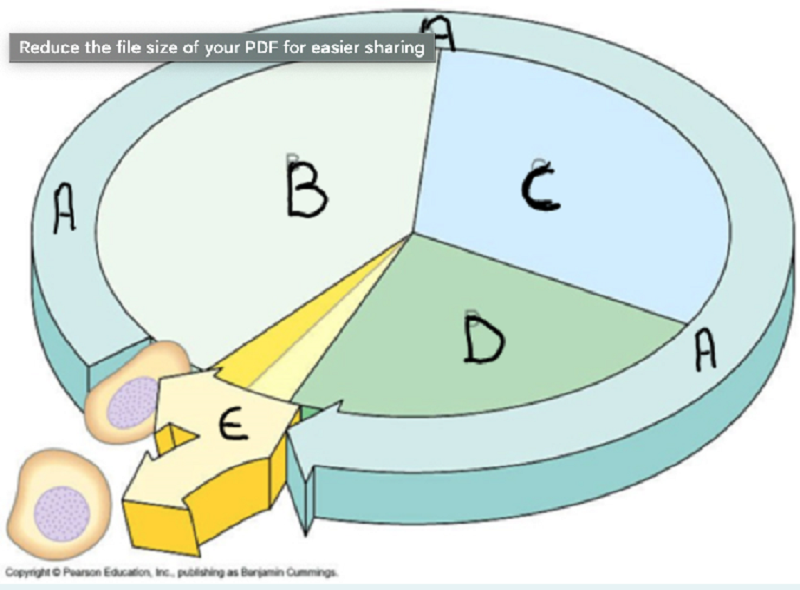
The section indicated with A is:
Telophase and Cytokinesis
Interphase
Mitosis
G2
Meiosis
Prophase
S
G1
Assume that coat colour in a certain species of animal is controlled by a single gene. You cross a black male with a white female to get all grey offspring. What kind of inheritance pattern is occurring?
Dihybrid Autosomal
Incomplete dominance
Sex-linked
There is not enough information here to make a good guess
Polygenic
Pleiotropy
Assume that coat colour in a certain species of animal is controlled by a single gene. You cross a black male with a white female to get all grey offspring. What kind of inheritance pattern is occurring?
Codominance
Sex-linked
Polygenic Inheritance
Simple Dominance
There is simply not enough information to make any kind of educated guess
Which blood type is considered the universal donor?
Type O
Type A
There is no universal donor, only a universal donor
Type AB
Type B
While studying a certain species of insect you notice that there are some individuals that are covered in small hairs (hairy), there are some that possess patches of hairs (patched), and there are some completely naked (naked). In a random sampling of the field population you find the following distribution: Out of a total of 132 sampled, 66 were males and 66 were females. Of the 66 males, 30 were hairy and 36 were naked. Of the 66 females, there were 22 hairy, 24 patched, and 20 naked. After spending some time thinking about this situation you preform a series of crosses that yielded the following results: (8) Male hairy X female naked: 22 patched females, 25 naked males. Male naked X female patched: 15 patched females, 17 naked females, 13 hairy males and 14 naked males. Explain the most likely inheritance pattern that is occurring here.
Sex-linked simple dominance with patched dominant
This can not happen because it appears to be sex-linked but males always show the condition when dealing with sex-linked traits.
There is insufficient information to formulate a solid explanation
Sex-linked simple dominance with patched the heterozygote
Autosomal codominance with patched being the heterozygote
Sex linked codominace with patched being the heterozygote
Sex-linked and patched always female

What best describes the chromosomes labelled D?
These are sister chromatids
There are unduplicated homologous pairs
These are duplicated homologous pairs
Assume that coat colour in a certain species of animal is controlled by a single gene. You cross a black male with a white female to get all grey offspring. You decide to cross a grey male with a black female, what would the offspring be?
All white offspring
25% white, 25% black, and 50% grey
All black offspring
50% black and 50% grey
50% black and 50% white
What is the following statement defining? This is where the effect of one gene directly effects the expression of another.
An allele
Codominance
Epistasis
Polygenic inheritance
Pleiotropy
Sex-linked trait
Polyploidy/Euploidy
Aneuploidy
What is the following statement defining? A trait that is associated with a gene found on one of the sex chromosomes.
An allele
Codominance
Epistasis
Polygenic inheritance
Pleiotropy
Sex-linked trait
Polyploidy/Euploidy
Aneuploidy
What is the following statement defining? The presence or absence of individual chromosomes from an individuals genotype.
An allele
Codominance
Epistasis
Polygenic inheritance
Pleiotropy
Sex-linked trait
Aneuploidy
Polyploidy/Euploidy
What is the following statement defining? The presence or absence of a complete set of chromosomes.
An allele
Codominance
Epistasis
Polygenic inheritance
Pleiotropy
Sex-linked trait
Aneuploidy
Polyploidy/Euploidy

What best describes the phase of cell division this cell is currently going through. The 2n number is 4.
Prophase mitosis
Anaphase meiosis 1
Metaphase meiosis 1
Prophase meiosis 1
Metaphase mitosis
Telophase meiosis 1
Telophase meiosis 2
Metaphase meiosis 2
Anaphase meiosis 2
Anaphase mitosis
Telophase mitosis
In a rare species of plant, the blue flower colour is dominant to red and small leaves are dominant to large. If two plants each heterozygous for both flower colour and leave size are crossed. Which answer best describes the expected ratio of the offspring?
None of these answers are correct
We cannot tell with the information given above
9:3:3:1
1:2:1
50:50
Which of the following would best describe a person with the sex chromosones XXY?
Male/Lacking secondary sex characteristics
Male/Taller than usual/Aggressive
Normal Female
Normal male
A male friend of yours who is blood type-A, is planning on having children with a woman who is blood type-B. The woman had one parent who was blood type-O. What would be the ratios and genotypes of children expected to be produced from these parents?
100% IAIB
100% ioio
50% IAIB, 50% IAio
25% Type-AB, 25% Type- A, 25% Type-B, 25% Type-O
100% Type-O
50% Type-AB, 50% Type-A
25% IAIB, 25% IAio, 25% ioio
Because we don't know know the genotype of the male, there is not enough information to properly answer this question.
What is the following statement defining? When one gene has an effect on two or more seemingly unrelated phenotypic traits.
Codominance
An allele
Pleiotropy
Common Inheritance
Epistasis
Polygenic inheritance
A person with the genetic condition OY has what condition
Turner's Syndrome
Meta Female
This is just a normal female genotype
Klinefelter's
This can not exist, because an embryo with no X sex chromosome will fail to develop
An albino man marries a normally pigmented women who has an albino mother. Show the genotypes of children that this couple may have and the proportions of each. (Albino is recessive; normal is dominant)
25% Albino (aa), 50% normal carriers (Aa), and 25% Normal (AA)
25% Albino (AA), 50% Albino Carriers (Aa), and 25% Normal (aa)
50% Albino (aa), 50% Normal Carriers (Aa)
50% Albino (AA) 50% Normal Carriers (Aa)

What best described the picture below?
It is a diagram of life
It is a diagram showing the cell cycle
It is a diagram showing mitosis
It is a diagram showing meiosis
A normal human gamete possesses how many chromosomes?
46
23
22
2
4

The section indicated with B is:
Mitosis and Cytokinesis
Prophase
Interphase
Mitosis
S
G2
Meiosis
G1
Cystic Fibrosis is a disease associated with:
A lack of an enzyme causing a buildup of chemical in the brain
The lack of an enzyme producing an unusually thick mucus
A slow degeneration of the nervous system
An unusual sickle shape of red blood cells
Sickle cell anemia is a potentially lethal disease, yet the allele for the disease remains relatively common in certain population. Why?
People who are homozygote for the disease are likely to have an increased rate of fertility
The populations where it is common tend to be relatively isolated
People who are heterozygote for the disease have an increased survival rate for malaria
People who are homozygote for the disease are likely to be more resistant to cholera
The population that have the disease tend to live in areas with a high incidence of cholera
A person with the genetic condition XO has what condition
Turner's Syndrome
Meta Female
This is just a normal female genotype
Klinefelter's
This can not exist, because an embryo with only one sex chromosome will fail to develop
If a single gene has just two different alleles, but produces three different phenotypes, what is the likely inheritance pattern?
Incomplete dominance
There is not enough information here to make a good guess
Pleiotropy
Sex-linked
Polygenic
In a certain species of fly, there are three hair types; hairy, stubbly, and smooth. When sampling the field population you find the following samples; 26 males and 18 females hairy, 17 females stubbly, and 28 males and 19 females smooth. Which of the following best describes the inheritance patter for this trait. Sex determination for this species is XY for male and XX for female. You do not need to do crosses to solve this... Look at the data given and think.
This is a simple autosomal recessive condition
This is a sex linked, co-dominant situation with stubbly being the heterozygote
This is a sex-linked, simple dominant situation with stubbly being the recessive trait
It is impossible to make any guesses due to a lack of information
The gene is a multiple allele, sex linked condition where the gene for stubbly is a lethal recessive

The section indicated with C is:
G2
G1
Telophase and Cytokinesis
Mitosis
Meiosis
S
Prophase
Interphase

What best describes the chromosome labelled B?
These are duplicated homologous pairs
These are unduplicated homologous pairs
These are unduplicated sister chromatids
If a certain person shows the characteristics of a recessive phenotype for a particular trait, what does this tell you about the person's genotype?
The person is homozygous for that trait
We cannot tell anything about the person's genotype without looking at their offspring
The person has recessive alleles for all traits
The person is an albino
The person has one recessive allele

What best describes the phase of cell division this cell is currently going through. The 2n number is 4
Telophase mitosis
Telophase Meiosis 2
Anaphase mitosis
Prophase mitosis or meiosis
Metaphase meiosis 1
Metaphase mitosis
Telophase meiosis 1
Anaphase meiosis 1
Metaphase meiosis 2
Anaphase meiosis 2

What best describes the phase of cell division this cell is currently going through. The 2n number is 4
Telophase mitosis
Telophase Meiosis 2
Anaphase mitosis
Metaphase meiosis 1
Metaphase mitosis
Telophase meiosis 1
Anaphase meiosis 1
Metaphase meiosis 2
Anaphase meiosis 2
Prophase meiosis 1
Prophase mitosis
Which term below best defines the following statement? A situation where a trait is controlled by two or more genes.
Codominance
Polygenic inheritance
An allele
Epistasis
Common inheritance
Pleiotropy
A person with the genotype XO will show what type of characteristics?
They will appear completely normal
They will generally be female with a slightly shorter stature with limited secondary sexual characteristics
They will be female and slightly taller than normal
This can not exist, because an embryo with only one X chromosome will fail to develop
This person will develop as male but will fail to show normal secondary sexual characteristics.
Which of the following is a sex-linked disease?
Dysentery
Chrones disease
Hemophilia
Sickle cell anemia
Cystic Fibrosis
Which of the following about Huntington's disease is true?
It only manifests itself later is life
It is found more in Asian Americans that any other racial group
It is a co-dominant condition
It is a recessive disease
It is only inherited by males

What best describes the phase of cell division this cell is currently going through. The 2n number is 4
Prophase mitosis
Anaphase meiosis 1
Metaphase meiosis 1
Prophase meiosis 1
Metaphase mitosis
Telophase meiosis 1
Telophase meiosis 2
Metaphase meiosis 2
Anaphase meiosis 2
Anaphase mitosis
Telophase mitosis
Interphase mitosis
Cytokinesis Mitosis
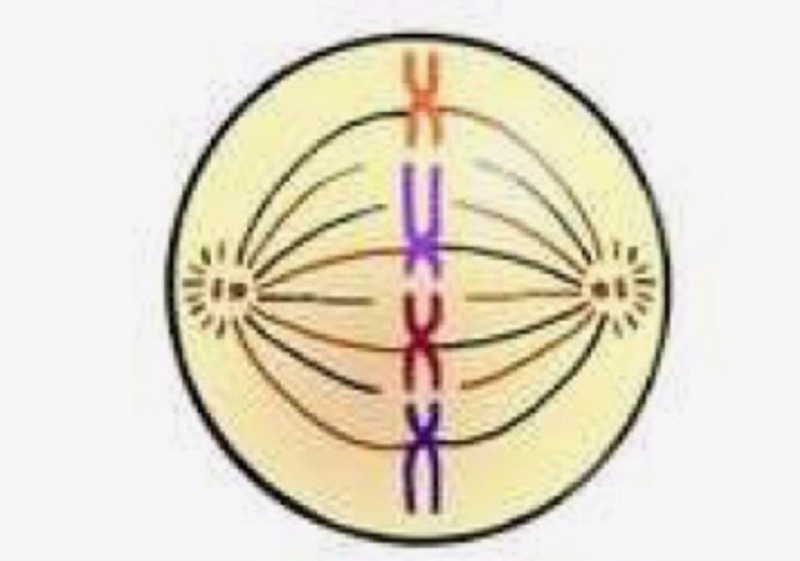
What best describes the phase of cell division this cell is currently going through. The 2n number is 4
Prophase mitosis
Anaphase meiosis 1
Metaphase meiosis 1
Prophase meiosis 1
Metaphase mitosis
Telophase meiosis 1
Telophase meiosis 2
Metaphase meiosis 2
Anaphase meiosis 2
Anaphase mitosis
Telophase mitosis
Interphase mitosis
Cytokinesis mitosis

What best describes the phase of cell division this cell is currently going through. The 2n number is 4
Prophase mitosis
Anaphase meiosis 1
Metaphase meiosis 1
Prophase meiosis 1
Metaphase mitosis
Telophase meiosis 1
Telophase meiosis 2
Metaphase meiosis 2
Anaphase meiosis 2
Anaphase mitosis
Telophase mitosis
Interphase mitosis
Cytokinesis mitosis

What best describes the phase of cell division this cell is currently going through. The 2n number is 4
Prophase mitosis
Anaphase meiosis 1
Metaphase meiosis 1
Prophase meiosis 1
Metaphase mitosis
Telophase meiosis 1
Telophase meiosis 2
Metaphase meiosis 2
Anaphase meiosis 2
Anaphase mitosis
Telophase mitosis
Interphase mitosis
Cytokinesis mitosis
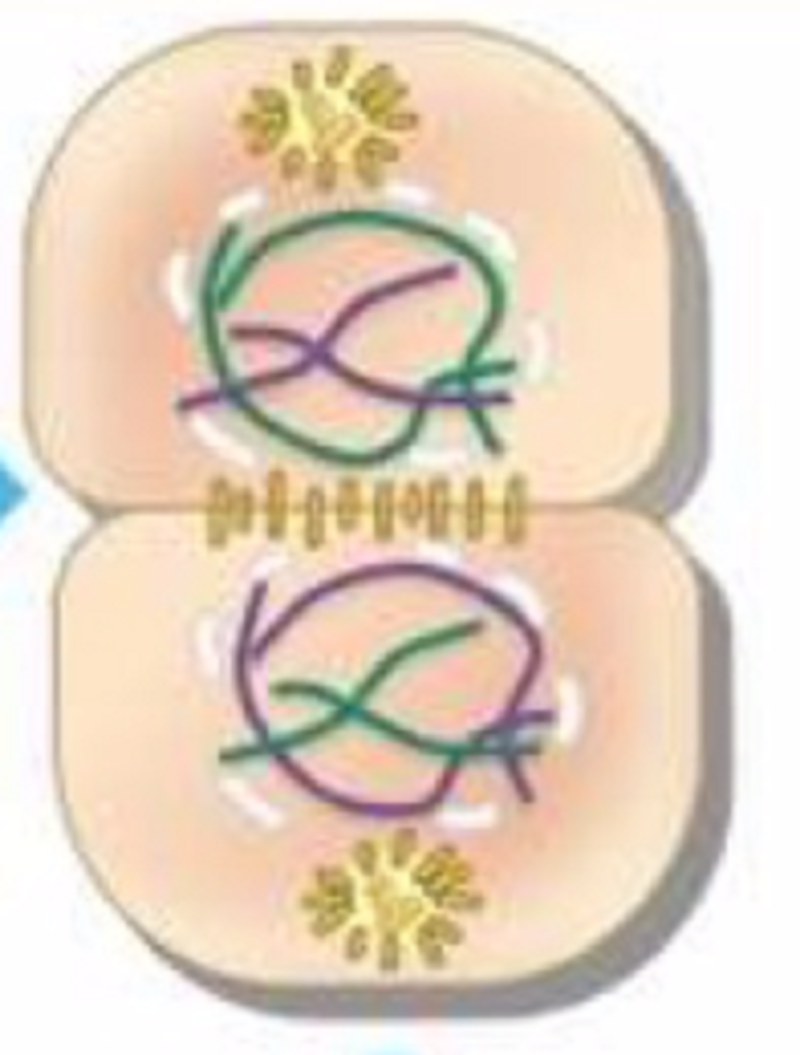
What best describes the phase of cell division this cell is currently going through. The 2n number is 4
Prophase mitosis
Anaphase meiosis 1
Metaphase meiosis 1
Prophase meiosis 1
Metaphase mitosis
Telophase meiosis 1
Telophase meiosis 2
Metaphase meiosis 2
Anaphase meiosis 2
Anaphase mitosis
Telophase mitosis
Interphase mitosis
Cytokinesis mitosis
Prophase meiosis 1

What best describes the phase of cell division this cell is currently going through. The 2n number is 4
Prophase mitosis
Anaphase meiosis 1
Metaphase meiosis 1
Prophase meiosis 2
Metaphase mitosis
Telophase meiosis 1
Telophase meiosis 2
Metaphase meiosis 2
Anaphase meiosis 2
Anaphase mitosis
Telophase mitosis
Interphase mitosis
Cytokinesis mitosis
Prophase meiosis 1

What best describes the phase of cell division this cell is currently going through. The 2n number is 4
Prophase mitosis
Anaphase meiosis 1
Metaphase meiosis 1
Prophase meiosis 1
Metaphase mitosis
Telophase meiosis 1
Telophase meiosis 2
Metaphase meiosis 2
Anaphase meiosis 2
Anaphase mitosis
Telophase mitosis
Interphase mitosis
Cytokinesis mitosis
Prophase meiosis 1
Which of the following best describes Huntington's disease?
Autosomal Aneuploidy
Sex-linked Aneuploidy
Autosomal dominance
Autosomal recessive
{"name":"Bio Midterm 2", "url":"https://www.quiz-maker.com/QPREVIEW","txt":"Welcome to the Biology Midterm 2 Quiz! Test your knowledge on various topics including genetics, cell division, and human diseases. This quiz is designed to challenge students and enthusiasts alike!66 QuestionsMultiple Choice FormatTrack Your Score","img":"https:/images/course6.png"}
More Quizzes
Bio Lecture: Test 1
402023
Practice quiz
1589
Maid of Honor Quiz
10538
What Type of Tree Are You?
7425
Dutch Bros - Test Your Coffee Menu Knowledge
201016599
Protected Disclosure - Which Definition Fits?
201017137
Which Zelda Character Are You? Free Online
201016832
Personal Finance - Free Quick-Check Practice
201017200
Alternative Versions of the Same Gene Are Called -
201023110
Do I Have Social Anxiety or Am I Just Shy? Free
201017137
Royale High Element - Which Magic Power Are You?
201016657
Free Psychopath Test - Self-Assessment With Results
201017263